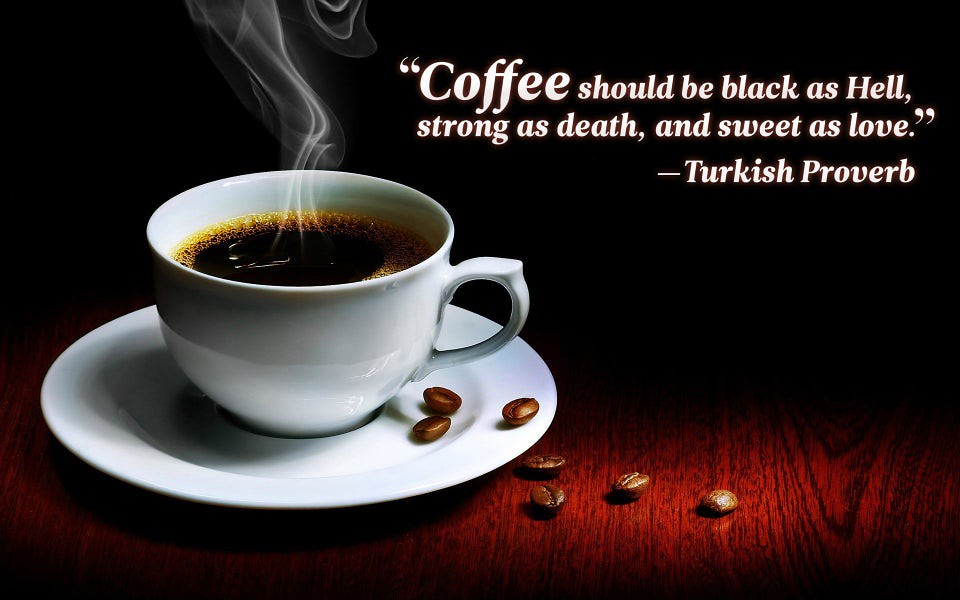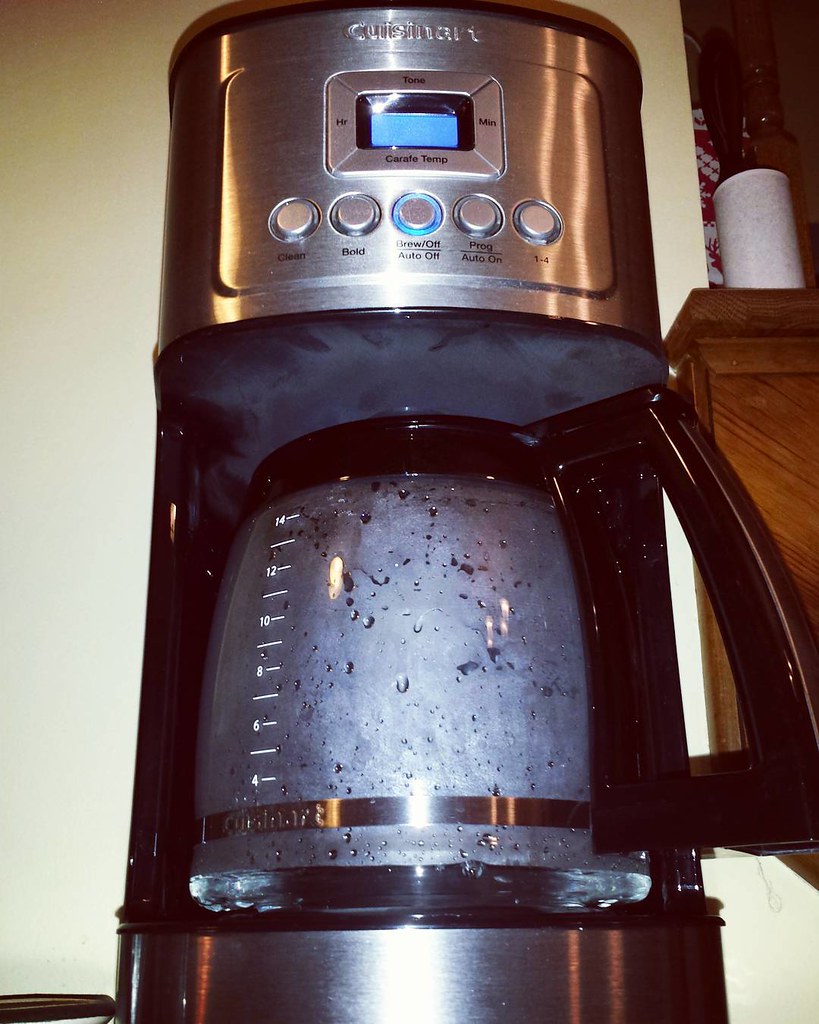So, let's talk about coffee!
I was slow to arrive at coffee, though I think I was always going to get there. I've loved the smell of coffee ever since I was very young; I remember making my mother let me take a nice, deep whiff from the Folger's can every time she went to make a pot, even if I didn't like the taste initially. It takes time to come around on a lot of flavors, especially the bitter ones, and I didn't really start shifting toward drinking coffee until college, when the flavor of coffee finally enticed me by way of Coffee Haagen-Dasz ice cream.
And now, years later, I'm a nut about coffee, which means that I have no fewer than four methods of brewing in regular use at Casa Jaquandor, and I'm intrigued enough by several others that I might, just might, look into them someday. But for now, here are the means of coffee prep in my house!
Automatic Drip
Now, I personally don't drink a lot of coffee from this machine (it's the source of The Wife's daily coffee), but it does make a nice cup. Ours is a Cuisinart with reusable gold mesh filter, a programmable timer, and several temperature settings. Lots of coffee partisans look down on the drip machine, but I honestly think they do just fine for day-to-day coffee.
Pourover
This is the method I use most frequently for my own personal daily coffee. I have two devices for the pourover method: a small brew basket for single cup brewing, and a larger pot for if I need more than a single cup at once. I'll brew the coffee into the big pot and then pour it into a thermal carafe for hotkeeping. (If 'safekeeping' is a word, why not 'hotkeeping'? Anyway….) This is all very simple. You put a filter in place, measure in your ground coffee, and then you pour boiling water over the grounds. It's basically the drip machine method, but executed manually. It also works better than most drip machines because you get to properly control the water temperature; many drip machines just don't get the water hot enough.
If you've heard of a "Chemex pot", my larger pot is pretty much that, only it's not the Chemex brand. You don't need to pay a lot for a specific brand name all the time!
French Press
I don't use this as often, but it makes delicious coffee with quite a different mouthfeel than the pourover. French press coffee isn't filtered, so a lot more of the oils from the bean end up in the final product, and all that direct contact between the water and the grounds makes for a stronger flavored brew. I own two French presses, one for whole pots and one for individual servings. Admittedly, I don't use the smaller one very often at all, but I love the larger one. (And that reminds me: as I write this I need to clean my French press, since I used it yesterday morning and didn't get around to cleaning it! The biggest drawback of the French press is likely that it's harder to clean than the other methods here.)
Moka pot
And then there's this gadget, which uses steam pressure to make very concentrated, strong coffee that's quite similar to espresso in flavor. In fact, some folks refer to this pot as a "stovetop espresso maker", which some other folks claim is inaccurate because of some stuff involving the proper levels of pressure under which the steam is forced through the coffee. I had to do a bit of research before I used this pot (how-to videos on YouTube are great!), and it's not hard at all! The most counterintuitive thing about the Moka pot is that you don't want to put cold water in the boiling chamber; the time it takes to heat the water to boiling ends up heating the grounds, which can make your brew taste burnt. You're actually instructed to boil the water first in a kettle before adding it to the boiling chamber, and then you put the whole kaboodle on the burner! It's neat the watch the coffee bubble up and out of the little tower in the pouring chamber, and I quite like the resulting coffee. (And I do get lazy on the whole 'boiling the water first' thing, sometimes using hot water from the tap.)
I only use the Moka pot for an afternoon cup of coffee during the cooler months. It doesn't make a big enough cup for "morning coffee", at least not for me. But it delivers a nice strong cup of espresso-style coffee!
So that's all I have right now for hot coffee-brewing methods. I do have a countertop espresso brewer someplace, but it's in the garage as it never really made it to my normal-use coffee rotation. I'm also intrigued by a gadget called the "Aero Press", and there's a thing called "Vietnamese coffee" that also intrigues (from what I understand, it's basically a drip filter of a special make). I wouldn't mind trying these, but space for kitchen gadgets is a concern, as is expense. (Not that these things are super expensive, but my desire to try each of these has not yet overridden my "Do I really wanna spend $20 or $30 on another coffee method just now?" thinking.)
I have, to my knowledge, never tried coffee brewed in a percolator. And honestly, from what I've read, I don't particularly plan to. I'm told that you can make good coffee in one, but honestly--I have all these other ways of making good coffee.
"But wait! What about cold brew coffee?"
I'm glad you asked!
I do like cold-brew coffee, which I keep on hand during the warmer months so I can enjoy a cold coffee beverage on occasion. I used to make my cold-brew in a large glass carafe that I have and use for several applications, because it's really easy. You don't need a special contraption for making cold-brew coffee; you just need a vessel for ground coffee and enough water for brewing (recipes containing amounts abound online). The issue that I ran into was draining and filtering the coffee out: this can become a pain that takes a long time, as you run the coffee through a strainer or a coffee filter. I'm not sure if it's a temperature thing or some other factor, but cold-brew coffee does not filter out nearly as quickly as hot coffee will.
So, I bought a cold-brew coffee pot. It's a simple concept, really: it's just a glass carafe with a lid, but there's also a wire-mesh basket that goes inside. You fill the basket with your coffee, put that in the carafe, and then pour in enough water to cover. You do this slowly, giving the coffee basket a quick spin a few times to make sure the water saturates the grounds, and then you just let it sit on the counter for 18-24 hours. (I always go 24.) Then you just lift out the mesh strainer-basket and hold it up to drip out for a minute or two, and what's left in the carafe is your cold-brew coffee concentrate.
I like to mix this stuff with milk and maybe a bit of chocolate syrup. Sometimes I also shake in one scoop of protein powder, but not always.
And finally, a shout-out to the unsung hero of all this: my electric kettle, which I use for boiling water quickly. Stove-top kettles used to be my jam, but not anymore. I am all about the speed and ease of the electric kettle, which makes my coffee and tea adventures an absolute breeze. I used to use a stove-top kettle for boiling water, but it takes way longer than an electric one to get the water to a boil.
So there it is: Coffee at Casa Jaquandor! Note that I do not own a Keurig machine, and nor do I have any intentions of owning one of those. They seem like a wasteful pain to me, a unitasker that just takes up a constant supply of counter space and involves waste in the form of all those little cups. Also, as brewing is cooking, I prefer to have as much control over things as I can.
So that's how I make my coffee. How do I take it? Most of the time, with cream (half-and-half, really) or black. While I used to put quite a bit of sugar into my coffee, I no longer use any sweetener at all. Coffee is one of the few areas of my culinary life where I've pretty much conquered my sweet tooth.
Now...what about mugs? And what about the other great hot beverage, tea?
Those are other posts. For now....



















I never heard of a moka pot. Interesting.
ReplyDeleteAnother way for me to... dare I say it... NOT drink coffee. Never got the habit.